ICS 5: Interpersonal Communication Skills for Children Report
VerifiedAdded on 2022/08/31
|7
|1334
|38
Report
AI Summary
This report delves into the critical aspects of interpersonal communication skills for children, targeting parents, teachers, and early childhood experts. It begins by outlining essential communication skills and identifying common barriers such as cognitive, language, and speech difficulties. The report then explores effective communication strategies to overcome these barriers, emphasizing the importance of demonstrating good interpersonal skills. It highlights the need for understanding verbal and non-verbal cues, providing freedom of expression, and offering support from professionals. Furthermore, the report identifies applicable resources, including speech therapy and platforms for practicing communication. The report concludes by emphasizing the significance of addressing communication barriers early in childhood to foster successful personal and professional lives, advocating for early schooling training in interpersonal communication skills. The provided references support the research and findings.
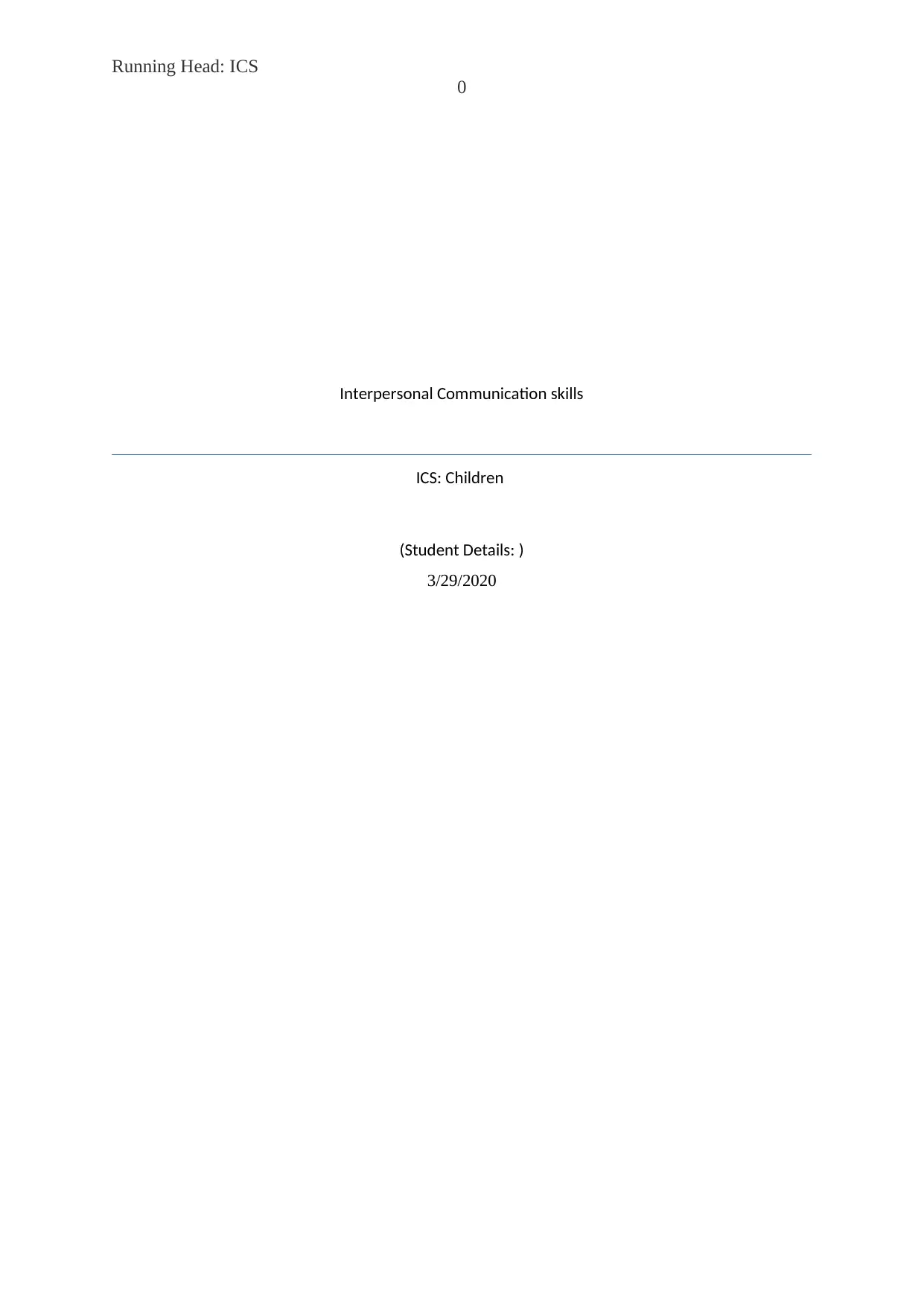
Running Head: ICS
0
Interpersonal Communication skills
ICS: Children
(Student Details: )
3/29/2020
0
Interpersonal Communication skills
ICS: Children
(Student Details: )
3/29/2020
Paraphrase This Document
Need a fresh take? Get an instant paraphrase of this document with our AI Paraphraser
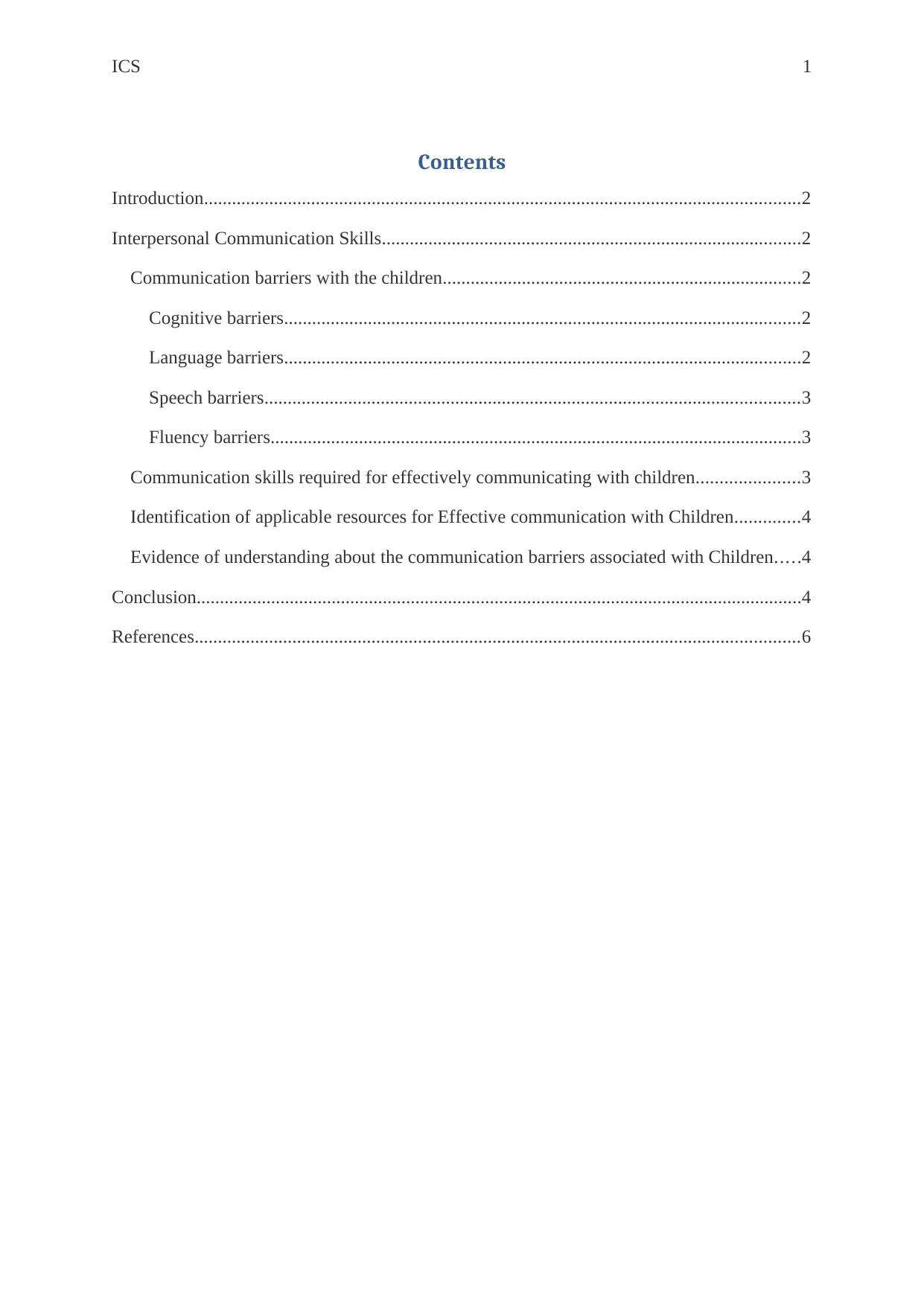
ICS 1
Contents
Introduction................................................................................................................................2
Interpersonal Communication Skills..........................................................................................2
Communication barriers with the children.............................................................................2
Cognitive barriers...............................................................................................................2
Language barriers...............................................................................................................2
Speech barriers...................................................................................................................3
Fluency barriers..................................................................................................................3
Communication skills required for effectively communicating with children......................3
Identification of applicable resources for Effective communication with Children..............4
Evidence of understanding about the communication barriers associated with Children.....4
Conclusion..................................................................................................................................4
References..................................................................................................................................6
Contents
Introduction................................................................................................................................2
Interpersonal Communication Skills..........................................................................................2
Communication barriers with the children.............................................................................2
Cognitive barriers...............................................................................................................2
Language barriers...............................................................................................................2
Speech barriers...................................................................................................................3
Fluency barriers..................................................................................................................3
Communication skills required for effectively communicating with children......................3
Identification of applicable resources for Effective communication with Children..............4
Evidence of understanding about the communication barriers associated with Children.....4
Conclusion..................................................................................................................................4
References..................................................................................................................................6
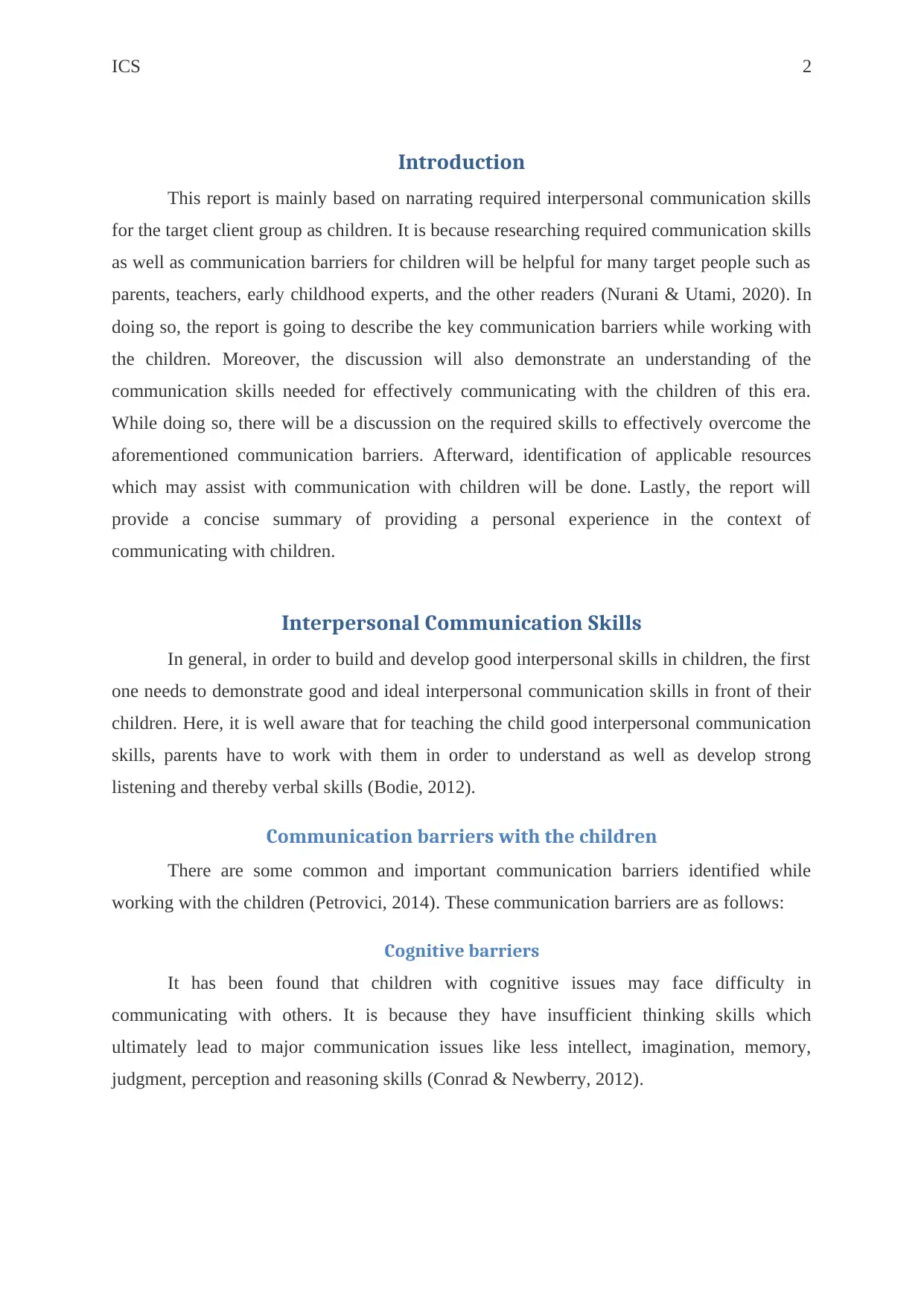
ICS 2
Introduction
This report is mainly based on narrating required interpersonal communication skills
for the target client group as children. It is because researching required communication skills
as well as communication barriers for children will be helpful for many target people such as
parents, teachers, early childhood experts, and the other readers (Nurani & Utami, 2020). In
doing so, the report is going to describe the key communication barriers while working with
the children. Moreover, the discussion will also demonstrate an understanding of the
communication skills needed for effectively communicating with the children of this era.
While doing so, there will be a discussion on the required skills to effectively overcome the
aforementioned communication barriers. Afterward, identification of applicable resources
which may assist with communication with children will be done. Lastly, the report will
provide a concise summary of providing a personal experience in the context of
communicating with children.
Interpersonal Communication Skills
In general, in order to build and develop good interpersonal skills in children, the first
one needs to demonstrate good and ideal interpersonal communication skills in front of their
children. Here, it is well aware that for teaching the child good interpersonal communication
skills, parents have to work with them in order to understand as well as develop strong
listening and thereby verbal skills (Bodie, 2012).
Communication barriers with the children
There are some common and important communication barriers identified while
working with the children (Petrovici, 2014). These communication barriers are as follows:
Cognitive barriers
It has been found that children with cognitive issues may face difficulty in
communicating with others. It is because they have insufficient thinking skills which
ultimately lead to major communication issues like less intellect, imagination, memory,
judgment, perception and reasoning skills (Conrad & Newberry, 2012).
Introduction
This report is mainly based on narrating required interpersonal communication skills
for the target client group as children. It is because researching required communication skills
as well as communication barriers for children will be helpful for many target people such as
parents, teachers, early childhood experts, and the other readers (Nurani & Utami, 2020). In
doing so, the report is going to describe the key communication barriers while working with
the children. Moreover, the discussion will also demonstrate an understanding of the
communication skills needed for effectively communicating with the children of this era.
While doing so, there will be a discussion on the required skills to effectively overcome the
aforementioned communication barriers. Afterward, identification of applicable resources
which may assist with communication with children will be done. Lastly, the report will
provide a concise summary of providing a personal experience in the context of
communicating with children.
Interpersonal Communication Skills
In general, in order to build and develop good interpersonal skills in children, the first
one needs to demonstrate good and ideal interpersonal communication skills in front of their
children. Here, it is well aware that for teaching the child good interpersonal communication
skills, parents have to work with them in order to understand as well as develop strong
listening and thereby verbal skills (Bodie, 2012).
Communication barriers with the children
There are some common and important communication barriers identified while
working with the children (Petrovici, 2014). These communication barriers are as follows:
Cognitive barriers
It has been found that children with cognitive issues may face difficulty in
communicating with others. It is because they have insufficient thinking skills which
ultimately lead to major communication issues like less intellect, imagination, memory,
judgment, perception and reasoning skills (Conrad & Newberry, 2012).
⊘ This is a preview!⊘
Do you want full access?
Subscribe today to unlock all pages.

Trusted by 1+ million students worldwide
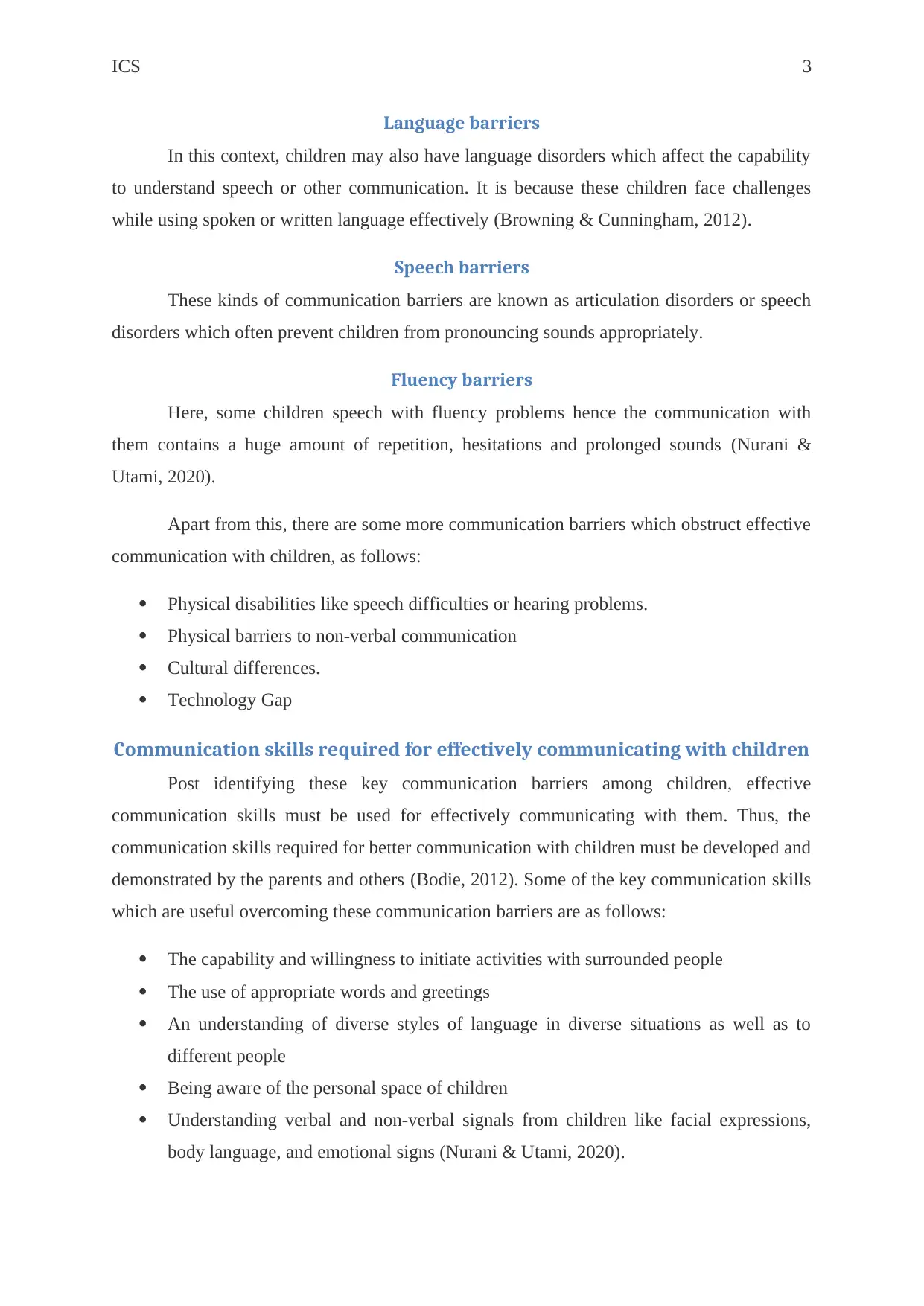
ICS 3
Language barriers
In this context, children may also have language disorders which affect the capability
to understand speech or other communication. It is because these children face challenges
while using spoken or written language effectively (Browning & Cunningham, 2012).
Speech barriers
These kinds of communication barriers are known as articulation disorders or speech
disorders which often prevent children from pronouncing sounds appropriately.
Fluency barriers
Here, some children speech with fluency problems hence the communication with
them contains a huge amount of repetition, hesitations and prolonged sounds (Nurani &
Utami, 2020).
Apart from this, there are some more communication barriers which obstruct effective
communication with children, as follows:
Physical disabilities like speech difficulties or hearing problems.
Physical barriers to non-verbal communication
Cultural differences.
Technology Gap
Communication skills required for effectively communicating with children
Post identifying these key communication barriers among children, effective
communication skills must be used for effectively communicating with them. Thus, the
communication skills required for better communication with children must be developed and
demonstrated by the parents and others (Bodie, 2012). Some of the key communication skills
which are useful overcoming these communication barriers are as follows:
The capability and willingness to initiate activities with surrounded people
The use of appropriate words and greetings
An understanding of diverse styles of language in diverse situations as well as to
different people
Being aware of the personal space of children
Understanding verbal and non-verbal signals from children like facial expressions,
body language, and emotional signs (Nurani & Utami, 2020).
Language barriers
In this context, children may also have language disorders which affect the capability
to understand speech or other communication. It is because these children face challenges
while using spoken or written language effectively (Browning & Cunningham, 2012).
Speech barriers
These kinds of communication barriers are known as articulation disorders or speech
disorders which often prevent children from pronouncing sounds appropriately.
Fluency barriers
Here, some children speech with fluency problems hence the communication with
them contains a huge amount of repetition, hesitations and prolonged sounds (Nurani &
Utami, 2020).
Apart from this, there are some more communication barriers which obstruct effective
communication with children, as follows:
Physical disabilities like speech difficulties or hearing problems.
Physical barriers to non-verbal communication
Cultural differences.
Technology Gap
Communication skills required for effectively communicating with children
Post identifying these key communication barriers among children, effective
communication skills must be used for effectively communicating with them. Thus, the
communication skills required for better communication with children must be developed and
demonstrated by the parents and others (Bodie, 2012). Some of the key communication skills
which are useful overcoming these communication barriers are as follows:
The capability and willingness to initiate activities with surrounded people
The use of appropriate words and greetings
An understanding of diverse styles of language in diverse situations as well as to
different people
Being aware of the personal space of children
Understanding verbal and non-verbal signals from children like facial expressions,
body language, and emotional signs (Nurani & Utami, 2020).
Paraphrase This Document
Need a fresh take? Get an instant paraphrase of this document with our AI Paraphraser
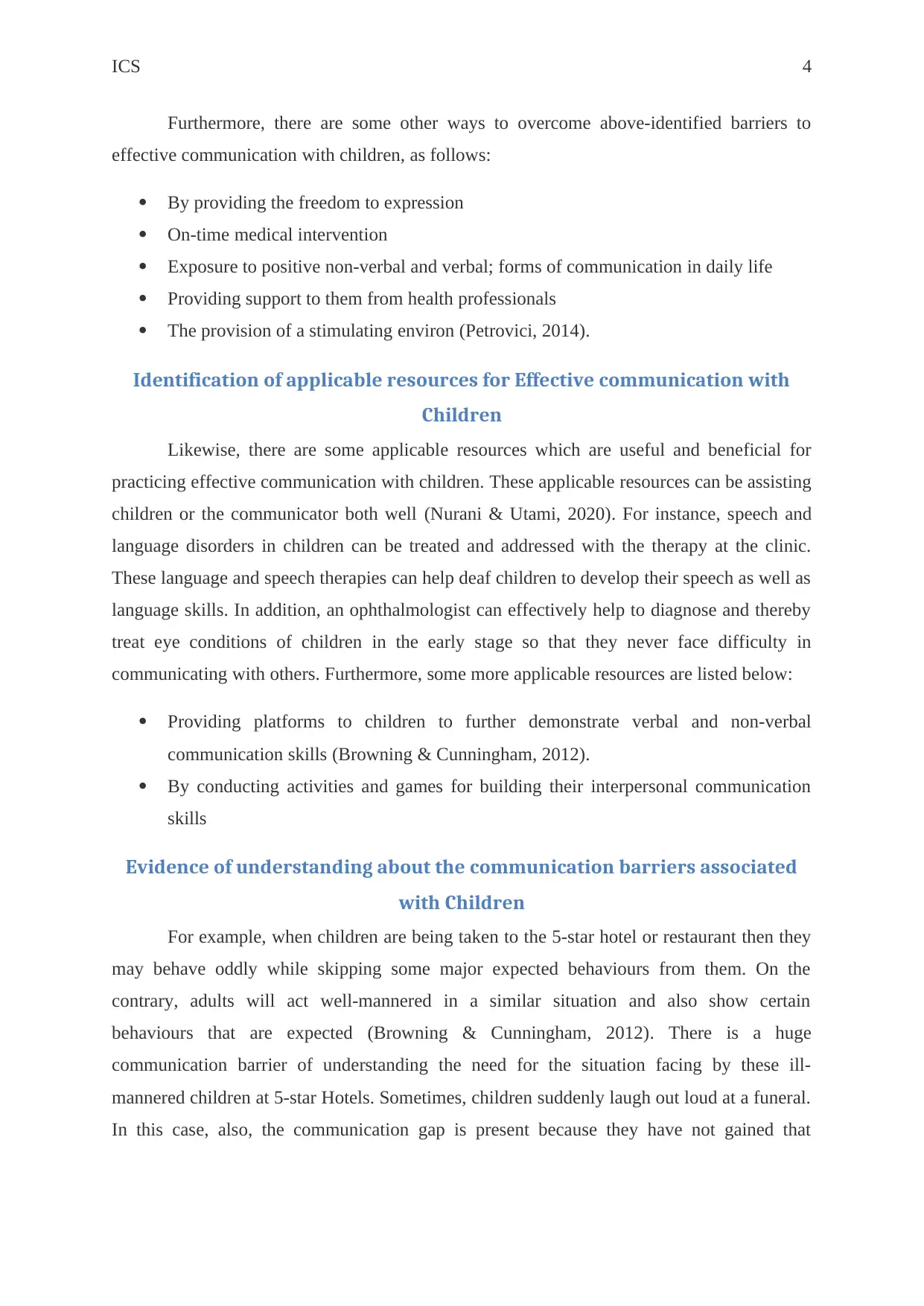
ICS 4
Furthermore, there are some other ways to overcome above-identified barriers to
effective communication with children, as follows:
By providing the freedom to expression
On-time medical intervention
Exposure to positive non-verbal and verbal; forms of communication in daily life
Providing support to them from health professionals
The provision of a stimulating environ (Petrovici, 2014).
Identification of applicable resources for Effective communication with
Children
Likewise, there are some applicable resources which are useful and beneficial for
practicing effective communication with children. These applicable resources can be assisting
children or the communicator both well (Nurani & Utami, 2020). For instance, speech and
language disorders in children can be treated and addressed with the therapy at the clinic.
These language and speech therapies can help deaf children to develop their speech as well as
language skills. In addition, an ophthalmologist can effectively help to diagnose and thereby
treat eye conditions of children in the early stage so that they never face difficulty in
communicating with others. Furthermore, some more applicable resources are listed below:
Providing platforms to children to further demonstrate verbal and non-verbal
communication skills (Browning & Cunningham, 2012).
By conducting activities and games for building their interpersonal communication
skills
Evidence of understanding about the communication barriers associated
with Children
For example, when children are being taken to the 5-star hotel or restaurant then they
may behave oddly while skipping some major expected behaviours from them. On the
contrary, adults will act well-mannered in a similar situation and also show certain
behaviours that are expected (Browning & Cunningham, 2012). There is a huge
communication barrier of understanding the need for the situation facing by these ill-
mannered children at 5-star Hotels. Sometimes, children suddenly laugh out loud at a funeral.
In this case, also, the communication gap is present because they have not gained that
Furthermore, there are some other ways to overcome above-identified barriers to
effective communication with children, as follows:
By providing the freedom to expression
On-time medical intervention
Exposure to positive non-verbal and verbal; forms of communication in daily life
Providing support to them from health professionals
The provision of a stimulating environ (Petrovici, 2014).
Identification of applicable resources for Effective communication with
Children
Likewise, there are some applicable resources which are useful and beneficial for
practicing effective communication with children. These applicable resources can be assisting
children or the communicator both well (Nurani & Utami, 2020). For instance, speech and
language disorders in children can be treated and addressed with the therapy at the clinic.
These language and speech therapies can help deaf children to develop their speech as well as
language skills. In addition, an ophthalmologist can effectively help to diagnose and thereby
treat eye conditions of children in the early stage so that they never face difficulty in
communicating with others. Furthermore, some more applicable resources are listed below:
Providing platforms to children to further demonstrate verbal and non-verbal
communication skills (Browning & Cunningham, 2012).
By conducting activities and games for building their interpersonal communication
skills
Evidence of understanding about the communication barriers associated
with Children
For example, when children are being taken to the 5-star hotel or restaurant then they
may behave oddly while skipping some major expected behaviours from them. On the
contrary, adults will act well-mannered in a similar situation and also show certain
behaviours that are expected (Browning & Cunningham, 2012). There is a huge
communication barrier of understanding the need for the situation facing by these ill-
mannered children at 5-star Hotels. Sometimes, children suddenly laugh out loud at a funeral.
In this case, also, the communication gap is present because they have not gained that
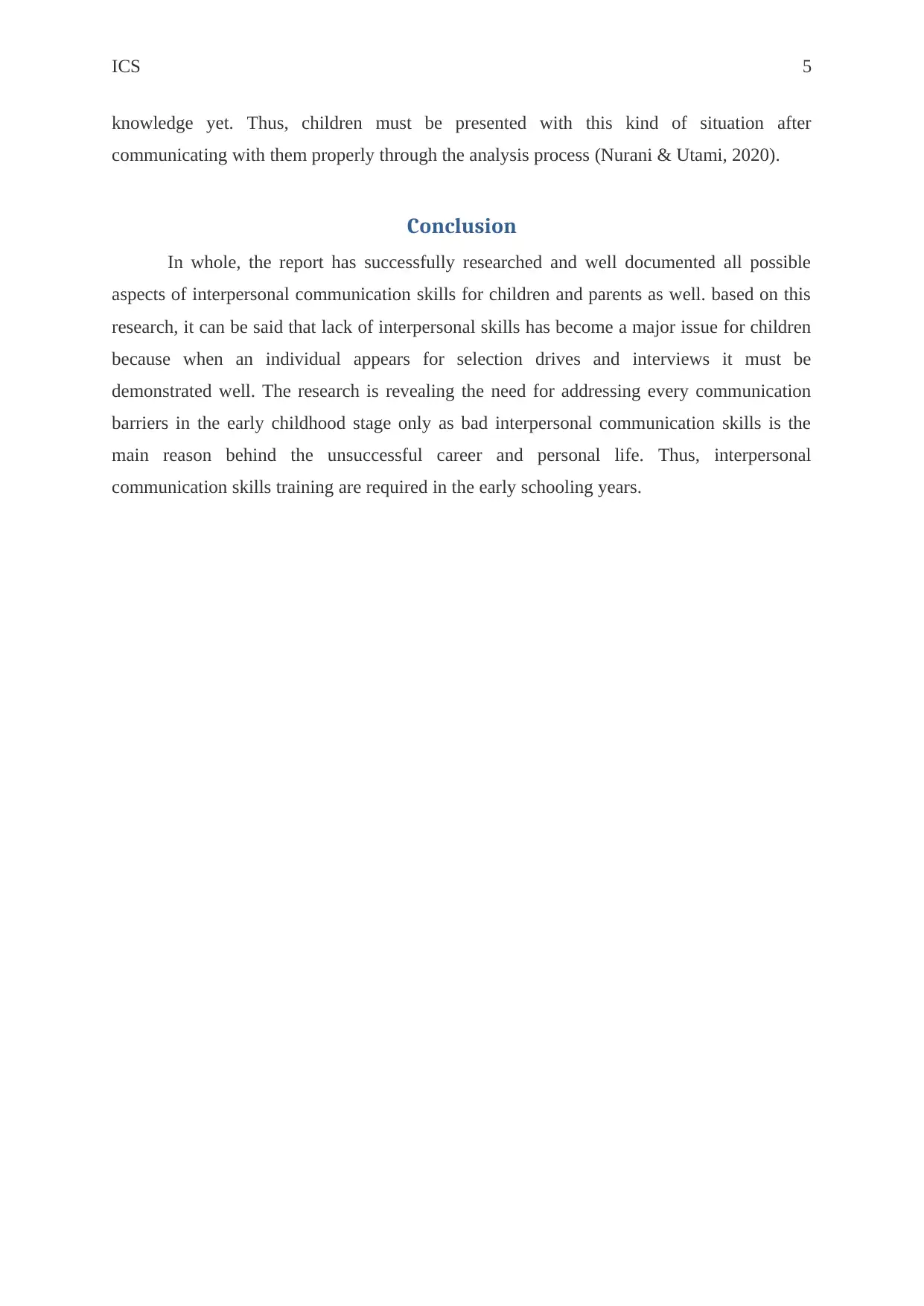
ICS 5
knowledge yet. Thus, children must be presented with this kind of situation after
communicating with them properly through the analysis process (Nurani & Utami, 2020).
Conclusion
In whole, the report has successfully researched and well documented all possible
aspects of interpersonal communication skills for children and parents as well. based on this
research, it can be said that lack of interpersonal skills has become a major issue for children
because when an individual appears for selection drives and interviews it must be
demonstrated well. The research is revealing the need for addressing every communication
barriers in the early childhood stage only as bad interpersonal communication skills is the
main reason behind the unsuccessful career and personal life. Thus, interpersonal
communication skills training are required in the early schooling years.
knowledge yet. Thus, children must be presented with this kind of situation after
communicating with them properly through the analysis process (Nurani & Utami, 2020).
Conclusion
In whole, the report has successfully researched and well documented all possible
aspects of interpersonal communication skills for children and parents as well. based on this
research, it can be said that lack of interpersonal skills has become a major issue for children
because when an individual appears for selection drives and interviews it must be
demonstrated well. The research is revealing the need for addressing every communication
barriers in the early childhood stage only as bad interpersonal communication skills is the
main reason behind the unsuccessful career and personal life. Thus, interpersonal
communication skills training are required in the early schooling years.
⊘ This is a preview!⊘
Do you want full access?
Subscribe today to unlock all pages.

Trusted by 1+ million students worldwide
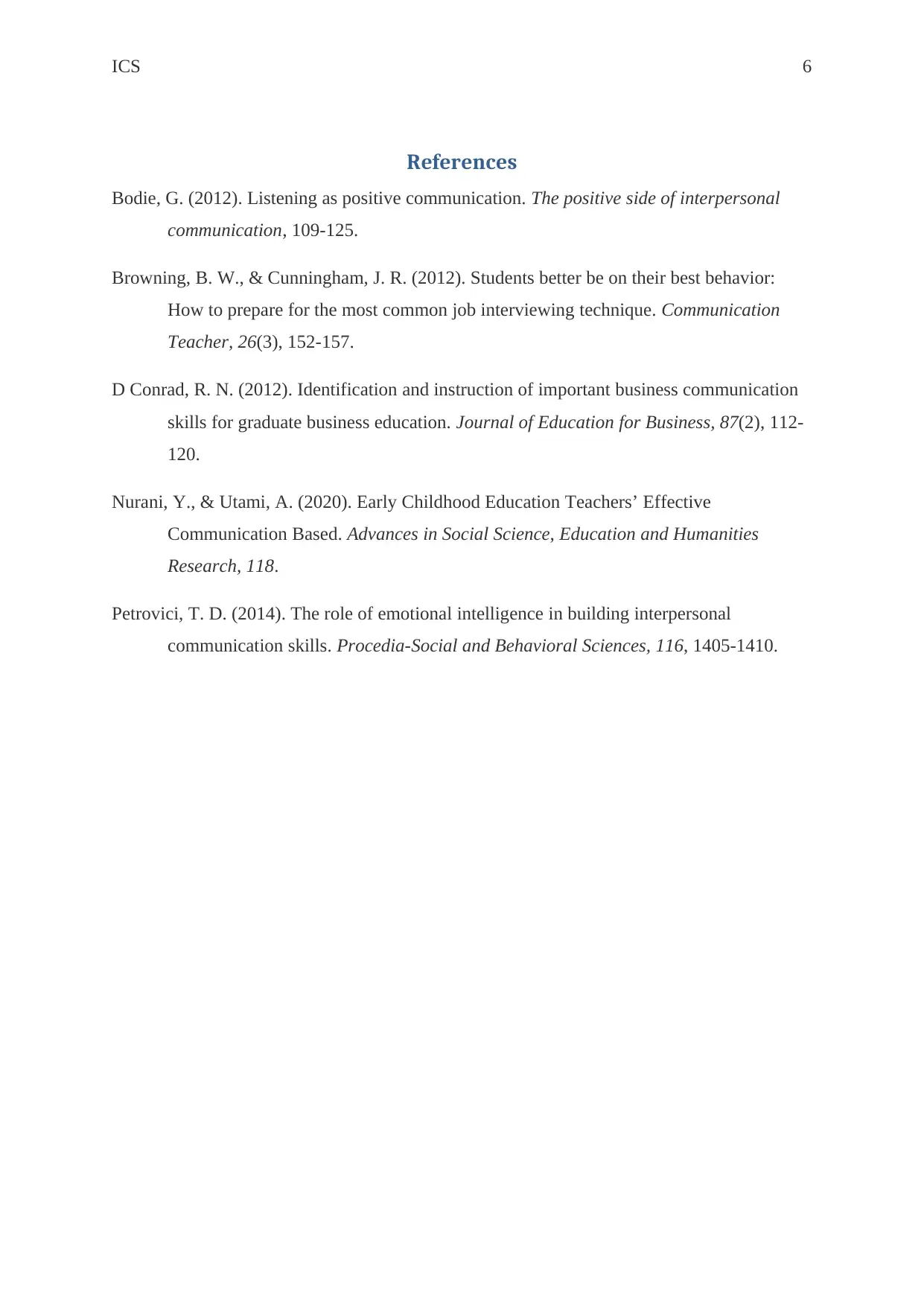
ICS 6
References
Bodie, G. (2012). Listening as positive communication. The positive side of interpersonal
communication, 109-125.
Browning, B. W., & Cunningham, J. R. (2012). Students better be on their best behavior:
How to prepare for the most common job interviewing technique. Communication
Teacher, 26(3), 152-157.
D Conrad, R. N. (2012). Identification and instruction of important business communication
skills for graduate business education. Journal of Education for Business, 87(2), 112-
120.
Nurani, Y., & Utami, A. (2020). Early Childhood Education Teachers’ Effective
Communication Based. Advances in Social Science, Education and Humanities
Research, 118.
Petrovici, T. D. (2014). The role of emotional intelligence in building interpersonal
communication skills. Procedia-Social and Behavioral Sciences, 116, 1405-1410.
References
Bodie, G. (2012). Listening as positive communication. The positive side of interpersonal
communication, 109-125.
Browning, B. W., & Cunningham, J. R. (2012). Students better be on their best behavior:
How to prepare for the most common job interviewing technique. Communication
Teacher, 26(3), 152-157.
D Conrad, R. N. (2012). Identification and instruction of important business communication
skills for graduate business education. Journal of Education for Business, 87(2), 112-
120.
Nurani, Y., & Utami, A. (2020). Early Childhood Education Teachers’ Effective
Communication Based. Advances in Social Science, Education and Humanities
Research, 118.
Petrovici, T. D. (2014). The role of emotional intelligence in building interpersonal
communication skills. Procedia-Social and Behavioral Sciences, 116, 1405-1410.
1 out of 7
Related Documents
Your All-in-One AI-Powered Toolkit for Academic Success.
+13062052269
info@desklib.com
Available 24*7 on WhatsApp / Email
![[object Object]](/_next/static/media/star-bottom.7253800d.svg)
Unlock your academic potential
Copyright © 2020–2025 A2Z Services. All Rights Reserved. Developed and managed by ZUCOL.





